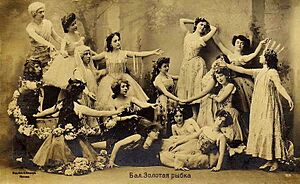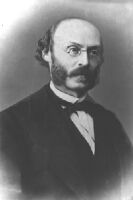Ludwig Minkus facts for kids
Quick facts for kids
Ludwig Minkus
|
|
|---|---|
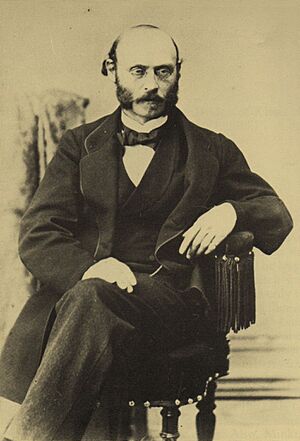
Maestro Ludwig Minkus, photographed by Bruno Braquehais. Paris, ca. 1870.
|
|
| Born |
Aloysius Bernhard Philipp Minkus
23 March 1826 |
| Died | 7 December 1917 (aged 91) Vienna, Austria-Hungary
|
| Occupation | Composer, violinist, teacher |
Ludwig Minkus (Russian: Людвиг Минкус), also known as Léon Fyodorovich Minkus, was an Austrian composer of ballet music. He was also a talented violinist and a music teacher. He was born on March 23, 1826, in Vienna and passed away on December 7, 1917, also in Vienna.
Minkus is famous for the beautiful music he wrote while working in St. Petersburg, Russia. From 1871, he held an important job as the Composer of Ballet Music for the St. Petersburg Imperial Theatres. He kept this role until he retired in 1886. During his time in St. Petersburg, Minkus created music for new ballets and older ones. These were staged by famous ballet masters like Arthur Saint-Léon and Marius Petipa. Some of his most well-known works include the music for La source (1866), Don Quixote (1869), and La Bayadère (1877). He also added music to older ballets, like the Grand Pas classique for Petipa's 1881 version of Paquita.
Contents
Early Life and Musical Beginnings
Ludwig Minkus was born Aloysius Bernhard Philipp Minkus on March 23, 1826. His birthplace was the Innere Stadt area of Vienna, which was the capital of the Austrian Empire. His father, Theodor Johann Minkus, was a wine merchant. His mother was Maria Franziska Heimann. Ludwig's parents became Catholic before they moved to Vienna.
Ludwig started learning to play the violin at just four years old. From 1838 to 1842, he studied music at the Gesellschaft der Musikfreunde in Vienna. He gave his first public performance in Vienna when he was eight. A newspaper in 1845 praised his playing, calling it "conservative" but with a "glittering performance." Soon, he was performing as a solo violinist in many concert halls.
While still a student, Minkus began writing music for his violin. Five of his violin pieces were published in 1846. Around this time, he also started trying his hand at conducting. For a while, he led an orchestra that competed with one led by the young Johann Strauss II.
Not much is known about Minkus's life between 1842 and 1852. We know he applied to travel to Germany, France, and England. In 1852, he became the main violinist for the Vienna Court Opera. However, he left this job the same year to take on an important music role abroad. This new role would change his life forever.
Moving to Russia
In 1853, Ludwig Minkus moved to Saint Petersburg, Russia. He became the conductor for the orchestra of Prince Nikolai Yusupov. He held this position until 1855. In the same year, Minkus married Maria Antoinette Schwarz. She was also from Vienna, Austria, born in 1838. They were married at the Catholic Church of St. Catherine in St. Petersburg.
From 1856 to 1861, Minkus was the main violinist and concert master for the orchestra of the Imperial Bolshoi Theatre in Moscow. He also conducted the Italian Opera there. By 1861, Minkus was promoted to a very important job: Inspector of Orchestras for the Moscow Imperial Theatres. At this time, he also taught violin at the new Moscow Conservatory.
Minkus wrote what might be his first ballet music for private shows at the Yusupov palace. This was L′Union de Thétis et Pélée (The Union of Thetis and Peleus), first performed in 1857. While working with the Imperial Bolshoi Theatre in Moscow, he composed another ballet. This was the one-act Deux jours en Venise (Two Days in Venice), which was performed in 1862.
Working with Arthur Saint-Léon

In 1862, Minkus was asked to compose a special violin piece. This piece was to be added to Adolphe Adam's ballet Orfa. The ballet was staged for the Bolshoi Theatre in Moscow by Arthur Saint-Léon. Saint-Léon was the main ballet master for the St. Petersburg Imperial Theatres. He also sometimes staged ballets for the Moscow group.
Saint-Léon then asked Minkus to write the music for his first full-length ballet. This was the three-act La Flamme d′amour, ou La Salamandre (The Flame of Love, or The Salamander). It was first performed for the Imperial Bolshoi Theatre of Moscow on November 24, 1863. Saint-Léon later brought the ballet to St. Petersburg. It was expanded and called Fiametta, ou L′amour du Diable. It premiered on February 25, 1864. Minkus also went with Saint-Léon to Paris to stage the ballet there. Its title changed again to Néméa, ou L′Amour vengé. Parisian critics, like Théophile Gautier, praised Minkus's music. They said it had a "haunting, dreamy quality" and "sparkling melodies."
In the fall of 1866, Saint-Léon was asked to stage a new work for the Paris Opéra. This was La Source. Minkus wrote this ballet together with composer Léo Delibes. Minkus composed all of Act I and part of Act III. Delibes wrote Act II and the other part of Act III. We don't know why they shared the work. La Source first showed on November 12, 1866. It was performed many times until 1876.
Saint-Léon continued to work with Minkus in the 1860s. On December 1, 1866, Saint-Léon presented his one-act ballet Le Poisson doré (The Golden Fish). This was staged at Peterhof to celebrate a royal wedding. Saint-Léon based this work on a Russian story by Alexander Pushkin. For the Imperial Ballet's 1867–1868 season, Le Poisson doré was expanded into a three-act ballet. It premiered on November 20, 1867. Minkus's music for this ballet included traditional Russian folk tunes. It also had special parts for solo flute, written for the famous flautist Cesare Ciardi.
The next season, Minkus and Saint-Léon created the ballet Le Lys (The Lily). It was based on a Chinese legend. The ballet first premiered on November 2, 1869. However, both Le Lys and the expanded Le Poisson doré were not very successful. Because of this, Saint-Léon's contract was not renewed, and he moved to Paris.
Working with Marius Petipa
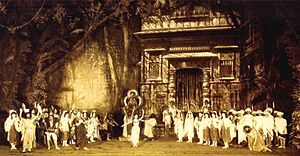
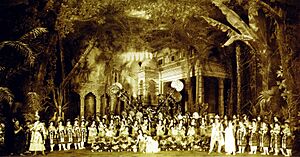
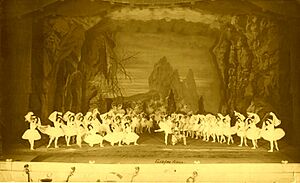
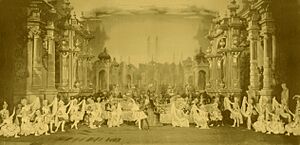
Through his work with Saint-Léon, Minkus caught the attention of the famous choreographer Marius Petipa. Petipa had arrived in St. Petersburg in 1847. He was a main dancer and assistant ballet master. The official ballet composer, Cesare Pugni, was getting older and less reliable. So, Saint-Léon and Petipa started to work with Minkus.
For the Moscow Imperial Bolshoi Theatre's 1869–1870 season, Petipa staged a big ballet based on Don Quixote. Petipa chose Minkus to write the music, and Minkus created a score full of Spanish style. Petipa's Don Quixote premiered on December 26, 1869, and was a huge success. It became a very famous work in classical ballet.
After Saint-Léon's death, Petipa became the main ballet master in St. Petersburg. Petipa staged a new version of Don Quixote for the Imperial Ballet. For this, Minkus completely rewrote and expanded his music. This new Don Quixote premiered on November 21, 1871, and was very successful. Minkus received great praise for his music. When Cesare Pugni died in January 1870, the job of official ballet composer was empty. With the success of Don Quixote, Minkus was given this important role. This began a long and successful partnership between him and Petipa.
Together, they created many ballets, including:
- La Camargo (1872)
- Le Papillon (1874)
- Les Brigands (The Bandits) (1875)
- Le Songe d'une nuit d'été (A Midsummer Night's Dream) (1876)
- Les Aventures de Pélée (The Adventures of Peleus) (1876)
- La Bayadère (1877) – This ballet became his most lasting and well-preserved work.
During this time, Minkus also continued to play the violin professionally. For example, he played second violin in the first performance of Tchaikovsky's String Quartet No. 1 in Moscow on March 28, 1871. Minkus often wrote special violin solos in his music for the great violinist Leopold Auer.
In 1883, Minkus composed music for Petipa's Nuit et Jour. This was a grand ballet staged for the coronation of Emperor Alexander III. The Emperor loved ballet and gave Minkus a special award, the Order of Saint Stanislaus, for his music. During the ceremony, the Emperor told Minkus, "you have reached perfection as a ballet composer."
Petipa's Les Pilules magiques (The Magic Pills) premiered on February 21, 1886. It was a big show for the newly renovated Imperial Mariinsky Theatre. This theatre became the main place for Imperial Ballet and Opera. Les Pilules magiques included comedy, singing, and Petipa's dance parts. Minkus wrote the music for the danced sections. The ballet had three fantasy scenes. One was in a cave with sorceresses. Another showed card games coming to life through dance. The last scene was called The Kingdom of the Laces, with national dances from different countries.
Minkus's next ballet music was for Petipa's one-act ballet L'Offrandes à l'Amour. It was staged on August 3, 1886. Critics at the time called Minkus's music a masterpiece. This was his last known ballet score for Petipa.
Retirement and Later Life
By 1886, Minkus's contract with the St. Petersburg Imperial Theatres was ending. The director, Ivan Vsevolozhsky, decided to end the official ballet composer position. He wanted to use music from different composers for new ballets. Minkus officially retired on November 21, 1886. His retirement performance included parts from Les pilules magiques and the Grand pas classique from Paquita.
Even after retiring, Minkus was asked to compose ballet music one last time in 1890. This was for Petipa's ballet Kalkabrino. It premiered on February 25, 1891. The ballet was not a big success. However, the young ballerina Mathilde Kschessinskaya later used it to help her own career.
Minkus and his wife, Maria, left Russia in the summer of 1891. They moved back to their home city of Vienna. The composer lived a quiet life on a small pension from the Tsar. For a time, he lived in an apartment belonging to his friend, the famous pianist and teacher Theodor Leschetizky. During these years, Minkus wrote his last known compositions. Das Maskenfest (The Masked Festival) was written in 1897 for the Vienna State Opera. However, the director, Gustav Mahler, rejected it. He felt the story was old-fashioned. Minkus then composed Die Dryaden (The Dryads), a one-act ballet, in 1899. The last work linked to Minkus before his death was Rübezahl, staged in 1907. It used music from his La Source and works by Johann Strauss II.
Minkus later moved to another apartment in Vienna. He spent his final years alone and in poverty. His wife had died in 1895. Also, World War I stopped his pension from Russia. During the very cold winter of 1917, Minkus got pneumonia. He passed away on December 7, 1917, at the age of ninety-one. He had no children.
Ludwig Minkus was buried at the Döbling Cemetery in Vienna. Sadly, in 1939, his grave was affected by the policies of the time. Cemeteries were "cleansed" by the invading regime. Graves of people considered "undesirable," especially those of Jewish background or without paid cemetery fees, were removed. Their remains were placed in a mass, unnamed grave.
Ballets
Imperial Bolshoi Kamenny Theatre, St. Petersburg
- Fiametta, ou L′amour du Diable (new staging of La Flamme d′amour, ou La Salamandre). Choreography by A. Saint-Léon. February 25, 1864.
- Le Poisson doré (expanded staging in three acts). Choreography by A. Saint-Léon. November 20, 1867.
- Le Lys. Choreography by A. Saint-Léon. November 2, 1869.
- La Camargo. Choreography by M. Petipa. December 29, 1872.
- Le Papillon. Choreography by M. Petipa. January 19, 1874.
- Les Brigands. Choreography by M. Petipa. February 6, 1875.
- Les Aventures de Pélée. Choreography by M. Petipa. January 30, 1876.
- Le Songe d'une nuit d'été. Based on Felix Mendelssohn's music. Choreography by M. Petipa. July 26, 1876.
- La Bayadère. Choreography by M. Petipa. February 4, 1877.
- Roxana, la beauté du Monténégro. Choreography by M. Petipa. February 10, 1878.
- La Fille des Neiges. Choreography by M. Petipa. January 19, 1879.
- Mlada. Choreography by M. Petipa. December 14, 1879.
- Zoraïa, ou La Maure en Espagne. Choreography by M. Petipa. February 13, 1881.
Imperial Bolshoi Theatre, Moscow
- Deux jours en Venise. Choreography by ?. 1862.
- La Flamme d′amour, ou La Salamandre. Choreography by A. Saint-Léon. November 24, 1863.
- Don Quixote (Original staging in 3 acts/8 tableaux). Choreography by M. Petipa. December 26, 1869.
- Nuit et Jour. Choreography by M. Petipa. May 30, 1883.
Works for other venues
- L′Union de Thétis et Pélée. Choreography by ?. 1857. Private Theatre of the Yusupov Palace, St. Petersburg.
- Néméa, ou L′Amour vengé (Reduced staging in two acts of Fiametta, ou L′amour du Diable). Choreography by A. Saint-Léon. July 11, 1864. Théâtre Impérial de l'Opéra, Paris.
- La Source (composed jointly with Léo Delibes). Choreography by A. Saint-Léon. November 12, 1866. Théâtre Impérial de l'Opéra, Paris.
- Le Poisson doré (Original staging in one act). Choreography by A. Saint-Léon. December 1, 1866. Amphitheatre of Olga's Island at Peterhof Palace, St. Petersburg.
- Les Pilules magiques. Choreography by M. Petipa. February 21, 1886. Imperial Mariinsky Theatre, St. Petersburg.
- L'Offrandes à l'Amour. Choreography by M. Petipa. August 3, 1886. Peterhof, St. Petersburg.
Images for kids
See also
 In Spanish: Ludwig Minkus para niños
In Spanish: Ludwig Minkus para niños


